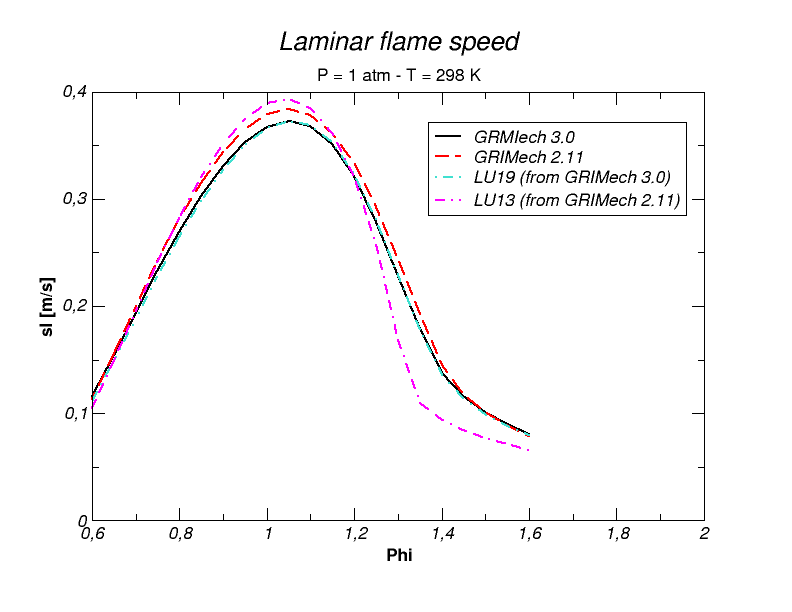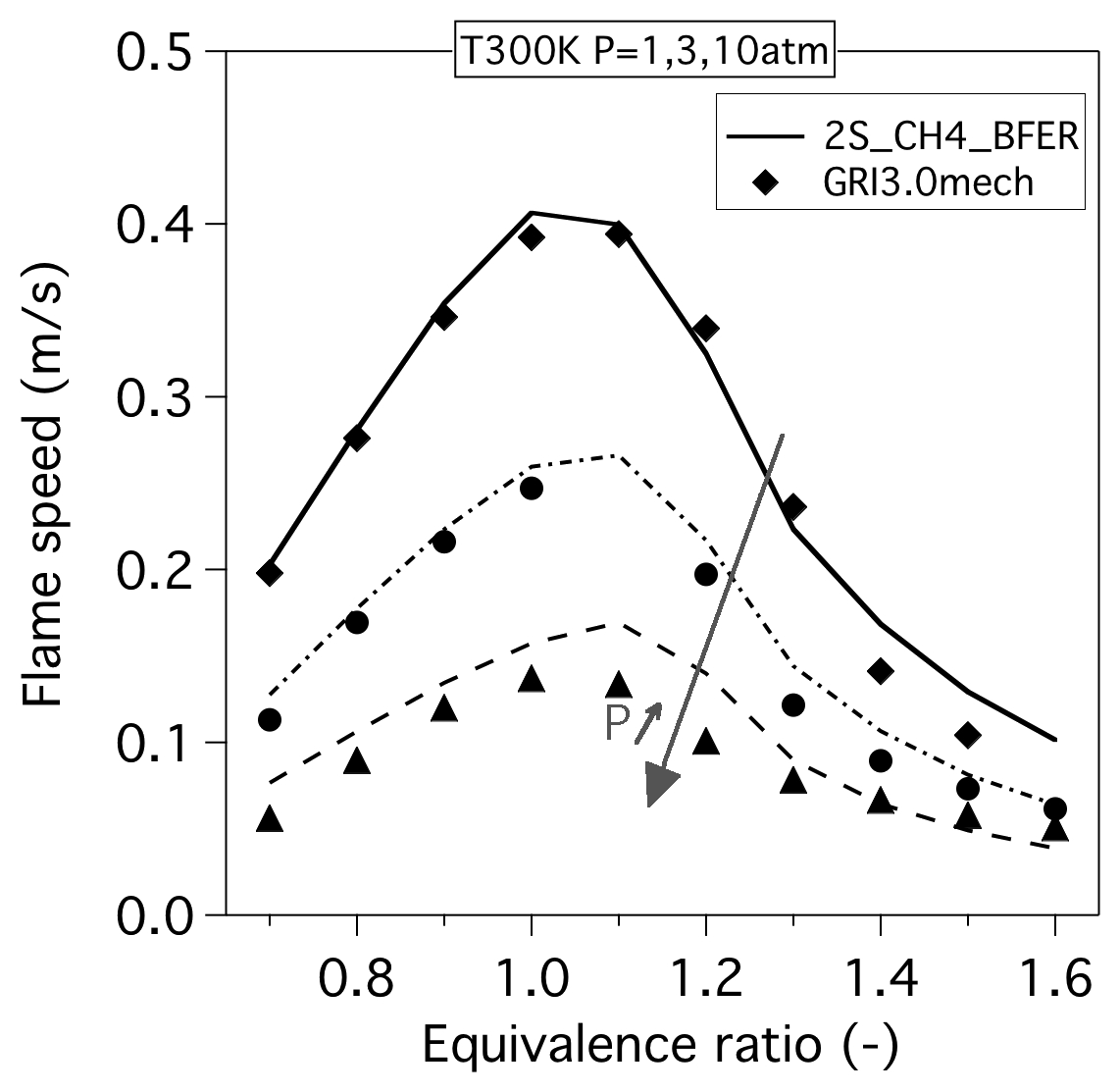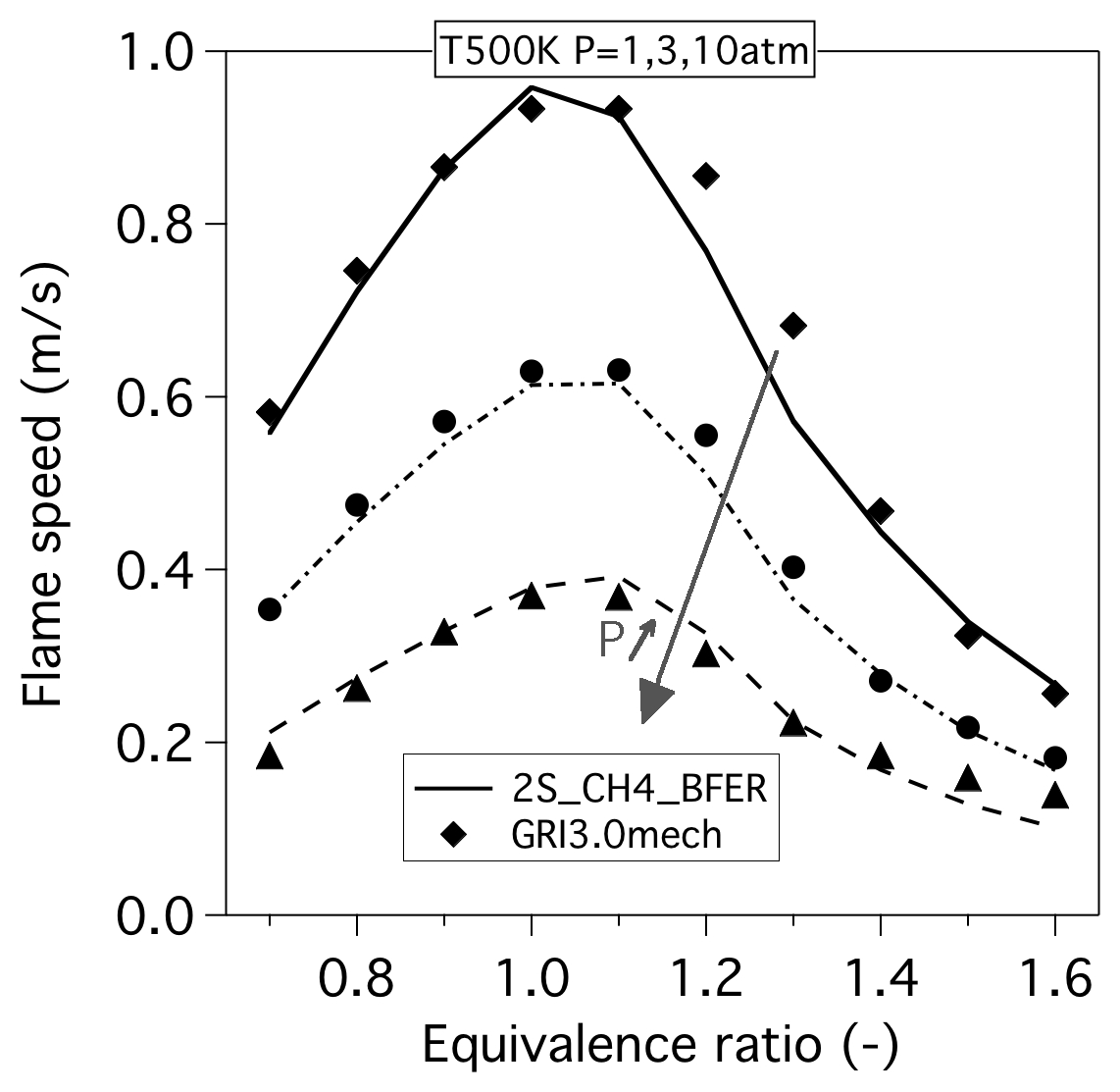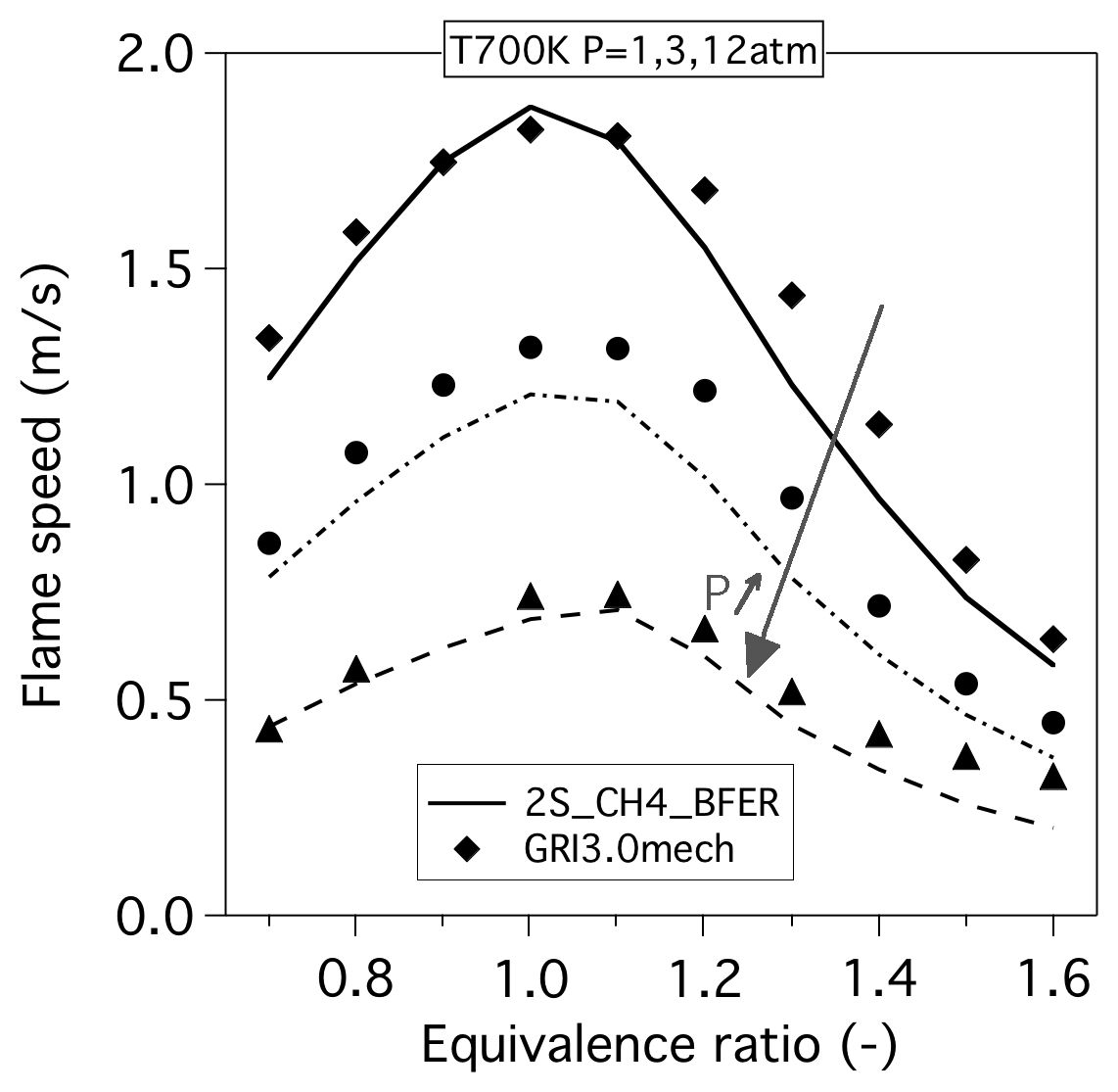Navigation
Methane/air combustion
In this section, different mechanisms for methane/air combustion are presented. The choice depends upon your application range, your simulation tool and the quantities that are of interest to you:
- Detailed mechanisms :
- Analytically reduced mechanisms :
Lu and Law's mechanism with 19 species
Lu and Law's mechanism with 13 species
A 22 species reduced mechanism derived with YARC (contains NOx)
- Global mechanisms :
BFER's mechanism with 2 global steps
You can find the datas provied on this page on the online database.
Please, note that unless explicitly specified, the output files provided in this website are a mean of comparison and are not necessarily formatted to be used as a restart file for cantera/can2av/...
Detailed mechanisms
The GRIMech 3.0 mechanism
This detailed mechanism for methane-air combustion is probably the most famous one. It is comprised of 325 reactions and 53 species. It is originally an optimized mechanism designed to model natural gas combustion, including NO formation and reburn chemistry. Detailed information about this standard mechanism can be found on this dedicated website. Here, you will also find the files in CHEMKIN format.
- Equilibrium
- Adiabatic temperature and species mole fractions vs stoichiometric ratio (.csv)
- Adiabatic temperature vs stoichiometric ratio (plot)
- Reactor
- 1D freely-propagating premixed flame
- Standard conditions : 298K - 1bar - phi=1 (csv file)
- Standard conditions : 298K - 1bar and various phi(restart xml file)
Equilibrium is computed under atmospheric pressure -holding it constant; at an initial temperature of 300K. The adiabatic flame temperature is obtained for a standard range of stoichiometric ratios. The following result files can be used to plot the results:
Constant volume homogeneous reactors are often employed to simulate auto-ignition. See here for examples of auto-ignition simulations, under various operating conditions. Plots of comparison with other mechanisms are also provided, when possible. Additionally, the script employed to perform the series of auto-ignitions is provided.
Here are data files for different conditions:

The GRIMech 2.11 mechanism
This detailed mechanism for methane-air combustion is an ancestor of the previous one, the GRIMech 3.0. It is comprised of 277 reactions and 49 species. Detailed information about this standard mechanism can be found on this dedicated website. Here, you will also find the files in CHEMKIN format.
If it is an "old" version, why bother ? It has been argued that with the newer 3.0 version, predicted levels of NO might be off, due to the production of too much NO. See, for example, Chapter 6 of the thesis of T. Jaravel.
- Equilibrium
- Reactor
- 1D freely-propagating premixed flame
Equilibrium is computed under atmospheric pressure -holding it constant; at an initial temperature of 300K. The adiabatic flame temperature is obtained for a standard range of stoichiometric ratios. The following result file can be used to plot the results. Note that the results are similar to those obtained with the 3.0 version of the mechanism:
Constant volume homogeneous reactors are often employed to simulate auto-ignition. See here for examples of auto-ignition simulations, under various operating conditions.
Here are data files for different conditions. Results differ from the 3.0 version:
Analytically reduced mechanisms
What differs with those type of mechanisms is that the source term of each species that remain is not expressed anymore as a combination of elementary reaction rates; but rather as a complex relation involving the detailed mechanism's reaction rates as well as the concentration of species that may not be amongst the reduced species set. Those mechanisms are characterized by the retained transported species, and are not associated with any "real" set of reactions, so that they require a special subroutine to override the classical evaluation of the species' source terms.
Lu and Law's mechanism with 19 species
This mechanism involves 19 species, and is derived from a 30 species skeletal mechanism for methane-air based on the GRIMech 3.0. The .cti file is available here. More information can be found on the website of Dr. Tiafeng Lu. In particular, the suitable kinetic routine for this ARC, as well as information about the 30 species skeletal mechanism, can be found on the website.
- Equilibrium
- Reactor
- 1D freely-propagating premixed flame
- Standard conditions : 298K - 1bar - phi=1 (csv file)
- Standard conditions : 298K - 1bar and various phi(restart xml file)
Equilibrium is computed under atmospheric pressure -holding it constant; at an initial temperature of 300K. The adiabatic flame temperature is obtained for a standard range of stoichiometric ratios. The following result file can be used to plot the results. Note that the results are similar to those obtained with the detailed mechanism (GRIMech 3.0):
Constant volume homogeneous reactors are often employed to simulate auto-ignition. See here for examples of auto-ignition simulations, under various operating conditions.
A data file is provided below, which can be used as an initial guess for the can2av tool :
A script is also provided, that enables you to compute any operating point of interest with Cantera 2.1.1 and to save properly your results for the can2av tool (AVBP V7.X).
Lu and Law's mechanism with 13 species
This mechanism involves 13 species and is derived from a 17 species mechanism for lean methane-air (flame speed only) based on the GRIMech 2.11. The .cti file is available here. More information can be found on the website of Dr. Tiafeng Lu. In particular, the suitable kinetic routine for this ARC (for a Cantera computation) as well as information about the 17 species skeletal mechanism can be found on the website.
For AVBP users: the kinetic subroutine associated with this mechanism can be found here (format F90), while the simplified transport data can be found on this file (AVBP formatted).
- Equilibrium
- Reactor
- 1D freely-propagating premixed flame
Just like for the GRIMech 2.11 mechanism, equilibrium is computed under atmospheric pressure -holding it constant; at an initial temperature of 300K. The adiabatic flame temperature is obtained for a standard range of stoichiometric ratios. The following result files can be used to plot the results. Note that the results are similar to those obtained with the detailed mechanism (GRIMech 2.11):
Constant volume homogeneous reactors are often employed to simulate auto-ignition. See this folder and this graph for examples of auto-ignition simulations, under various operating conditions.
A data file is provided below, which can be used as an initial guess for the can2av tool :
A 22 transported species ARC with NO chemistry (derived with YARC by Thomas Jaravel)
This ARC was developped with YARC based on laminar premixed flames under atmospheric conditions, but it has been shown to work over a broader range of operating conditions. It was derived based on the GRIMech 2.11 mechanism, and it contains a NOx submechanism. It is comprised of 22 transported species, 18 QSS species and 320 reactions. Information about it can be found in Thomas Jaravel's PhD thesis.
The kinetic subroutine associated with this mechanism can be found here (format F90). The simplified transport data can be found on this file (AVBP formatted).
Global mechanisms
The BFER's mechanism
This simplified model uses 6 species for 2 global reactions (fuel oxidation and CO-CO2 equilibrium). The consideration of few reactions and species requires less memory and leads to a very fast computation. This scheme correctly predicts the laminar flame speed on a wide range of fresh gas temperature [(300;700) K], pressure [(1;12) atm] and equivalence ratio [(0.6;1.5)] as well as the burnt gas temperature for an equivalence ratio below 1.4.
More details are provided in this article.
- Equilibrium
- Mole fractions vs stoichiometric ratio (.csv)
- Adiabatic temperature vs stoichiometric ratio (.csv)
- Adiabatic temperature vs stoichiometric ratio (plot)
- Reactor
- Consant Pressure reactor at 1500K - 1atm - Phi = 1 (.csv)
- Consant Pressure reactor at 1500K - 1atm - Phi = 1 (plot)
- 1D freely-propagating premixed flame
Equilibrium is computed under atmospheric pressure -holding it constant; at an initial temperature of 300K. The adiabatic flame temperature is obtained for a standard range of stoichiometric ratios. The following result files (.csv, .txt) can be used to plot the results :
Combustion inside an isobaric homogenous reactor is simulated, at stoichiometry, under atmospheric pressure, and for an initial temperature of 1500K. A quick comparison with results obtained on the detailed mechanism will show you that such a simple chemical scheme, with so few species, is not able to reproduce the complexity of the ignition phenomena :
A data file is provided below, which can be used as an initial guess for the can2av tool :
In order to compute this mechanism with the AVBP transport model you will need the following input files (.dat) :
And if you want to perform calculation with rich mixtures, you might want to use the PEA formalism (see the AVBP website for more information on the PEA formalism) :
A script is also provided, that enables you to compute any operating point of interest with cantera version 2.1.1 and to save properly your results so that you can perform a can2av with the version 7 of AVBP.



Another 2 step mechanism : 2S_CH4_CM2
This simplified model involves 6 species into 2 global reactions. This mechanism is not good under rich conditions.
- Equilibrium
- 1D freely-propagating premixed flame
As the present species are the same than in the BFER scheme presented above, the equilibrium calculations will return the same results. Please, refer to the BFER section.
A data file is provided below formatted for can2av:
In order to compute these mechanisms with the AVBP transport model you will need the following input files (.dat, no PEA provided) :
1 step mechanism : 1S_CH4_MP1
This simplified model involves 5 species into 1 single global reactions. Adiabatic flame temperatures are not very well predicted. Whenever possible, it is best to use a two step scheme !
- Equilibrium
- Mole fractions vs stoichiometric ratio (.csv)
- Adiabatic temperature vs stoichiometric ratio (.txt)
- Adiabatic temperature vs stoichiometric ratio (plot)
- 1D freely-propagating premixed flame
Equilibrium is computed under atmospheric pressure -holding it constant; at an initial temperature of 300K. The adiabatic flame temperature is obtained for a standard range of stoichiometric ratios. The following result files (.csv, .txt) can be used to plot the results :
A data file is provided below formatted for can2av:
In order to compute these mechanism with the AVBP transport model you will need the following input files (.dat, no PEA provided) :